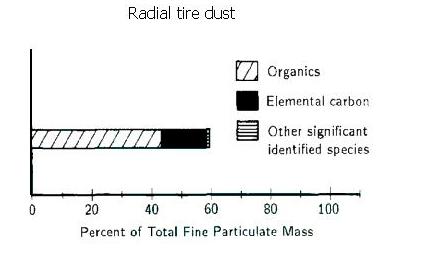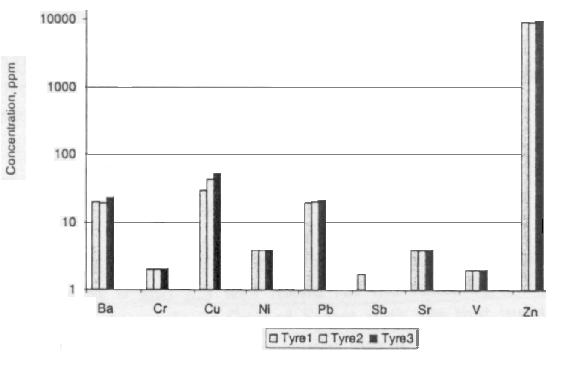
A wide range of chemical compounds can be found in the tyre rubber of road vehicles and in the gases emitted from tyre abrasion. In the literature, information concerning the chemical composition of tyre material and the chemical composition of tyre wear particulate matter can be found.
Chemical composition of tyre material
A wide range of chemical compounds, such as natural rubber, SBR (styrene butadiene rubber), and butadiene rubber, can be found in the tyre rubber of road vehicles. Chemical analysis of tyre material has also revealed that metals such as Zn, Fe and Ca can be present in different concentrations. A large variety of other chemical substances are also added to tyre rubber : vulcanising agents, accelerators, retardants, pigments, fillers, reinforcing agents, softeners, anti-oxidants, anti-ozonants and desiccants. Some results from experiments carried out to determine the chemical specification of tyre material are shown below.
1. Source : Fauser 1999
Results : Compositions by weight in tyre rubber :
2. Source : Hildemann 1991; Rogge et al 1993; Kumata et al 1996 and 2000; Fishman and Turner 1999
Results : These surveys showed that the bulk (40-60%) of tyre tread is composed of a variety of rubbers, including natural rubber co-polymers, butadiene rubber, styrene butadiene rubber (SBR), nitride rubber, isoprene rubber, neoprene rubber and polysulphide rubber.
3. Source : Non-exhaust particle emissions from road transport (2002), L.R. Warner, R.S. Sokhi, L. Luhana, P.G. Boulter, I. McCrae
Method : Sampling and chemical analysis of tyre material. Tyre lining was obtained by grating 3 used tyres and the material concentrated was then passed through a succession of sieves with a final sieve being 60 micron pore size.
Results : Trace elemental composition of tyre material

4. Source : Malmqvist 1983; Hewit and Rashed 1990; Brewer 1997; VROM 1997; Legret and Pagotto 1999
Method : -
Remarks : The metal content of tyres has been determined in these studies concerned with highway run-off.
Results : Elemental metal content of tyre rubber
| Metal | Concentration range (mg/kg) | Metal | Concentration range (mg/kg) |
| Ag | 0.08 | Mg | 32-106 |
| As | 0.8 | Mn | 2 |
| Al | 81-420 | Mo | 2.8 |
| Ba | 0.9-4.1 | Na | 610 |
| Ca | 113-562 | Ni | 0.9-50 |
| Cd | 0.28-4.96 | Pb | 1-160 |
| Co | 0.88-24.78 | Sb | 2 |
| Cr | 0.4-6.73 | Se | 20 |
| Cu | 1.8-29.3 | Sr | 1.16-3.13 |
| Fe | 2.12-533 | Ti | 195 |
| K | 180 | V | 1 |
| Li | 0.23-2.3 | Zn | 8378-13494 |
5. Source : Evaluation of pollutant loadings in the runoff waters from a major rural highway, M. Legret, C. Pagotto 1999
Method : Laboratory measurements to find heavy metal concentrations in tyres
Results : The results presented below are also included in the previous table which summarises data from different surveys.
Chemical composition of tyre wear particulate matter
A survey has shown that about half of the total particulate mass in a tyre wear sample was composed of organic compounds, with a further sixth being elemental carbon [Hildemann et al. (1991)]. The same survey revealed a zinc concentration lower than expected. Other experiments, which analysed tyre wear dust samples using gas chromatography/mass spectrometry techniques, determined the existence of more than 100 solvent-extractable organic compounds [Rogge et al. (1993)]. In the same survey, it was noted that tyre wear particles contain an appreciable amount of styrene and butadiene polymers, and also a quantity of polycyclic aromatic hydrocarbons (PAH). A summary of the information found in the literature regarding the different compounds (organic,inorganic) and their concentrations in tyre wear particles is given below.
1. Source : Emission factors for fine dust from road traffic, Second International ETH Workshop on Nano-particulate Measurment (August 7, 1998)
Remarks : The study compiled data on emissions of particulate air pollutants originating from road traffic. The data came from publications (approximately 300) direct inputs from industry and from the Swiss occupational health project VERT during 1993 and 1997.
Results : tyre wear particulate matter consists of
2. Source : Sources of fine organic aerosol. 3. Road dust, tyre debris and organometallic brake lining dust: Roads as sources and sinks, Wolfgang F. Rogge, Lynn M. Hildemann, Monica A. Mazurek and Glen R. Cass 1993
Method : Gass chromatography/Mass spectrometry (Sample collection, sample extraction, sample analysis, compound identification and quantification)
Results :
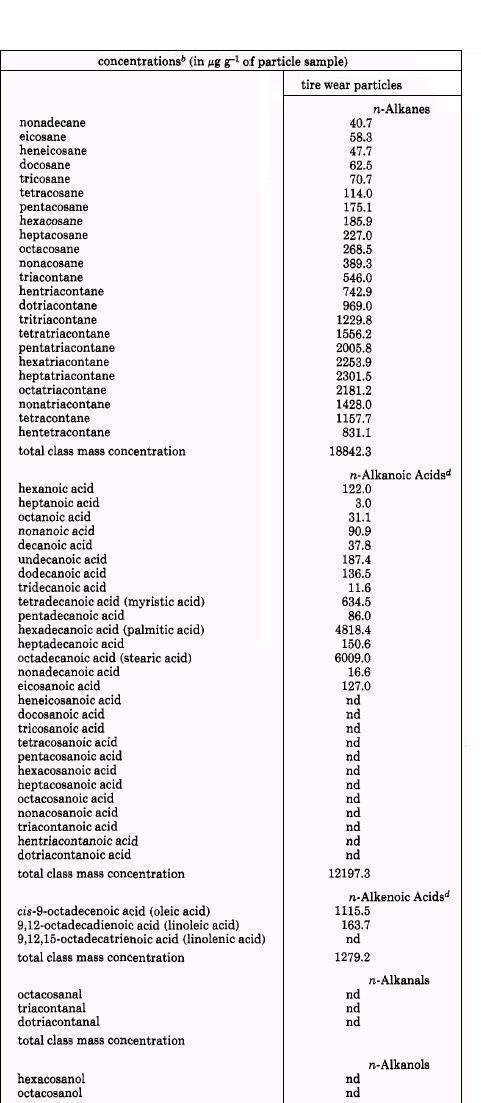
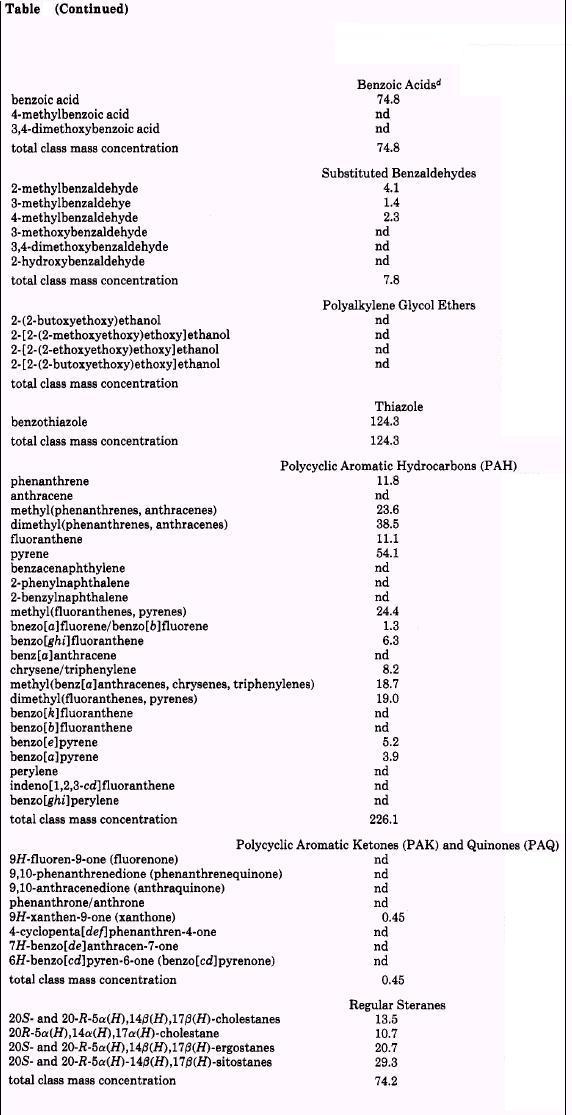
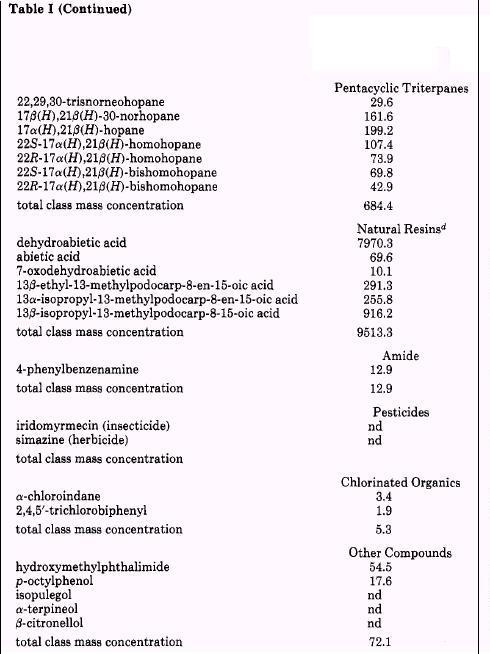
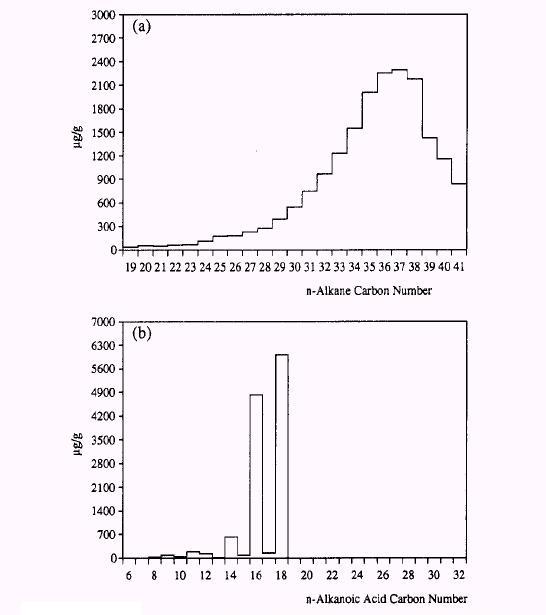
3. Source : Chemical composition of emissions from urban sources of fine organic aerosol, Lynn M. Hildemann, Gregory R. Markowski, Glen R. Cass, 1991
Results : Inorganic compounds found in tyre wear particles
| Species | tyre wear (% of mass) |
Species | tyre wear (% of mass) |
|---|---|---|---|
| Al | 0.047 | As | 0 |
| Si | 0.180 | Se | 0.002 |
| P | 0 | Br | 0.002 |
| S | 0.110 | Rb | 0 |
| Cl | 0.052 | Sr | 0.004 |
| K | 0.038 | Ba | 0.037 |
| Ca | 0.2 | Pb | 0.016 |
| Ti | 0.056 | EC | 15.3 |
| V | 0 | OC | 36 |
| Cr | 0.003 | Mg+2 | 0.036 |
| Mn | 0.010 | Na+ | 0.068 |
| Fe | 0.460 | Cl- | 0.060 |
| Ni | 0.005 | NO-3 |
0.150 |
| Cu | 0.049 | SO4-2 | 0.250 |
| Zn | 0.043 | NH4+ |
0.019 |
4. Source : Chemical composition of emissions from urban sources of fine organic aerosol (1991), Hildemann L M, Markowski G R, Cass G R
Method : A total particle sample was collected directly onto filters giving a sample that was mainly composed of coarse particles.
Results :
